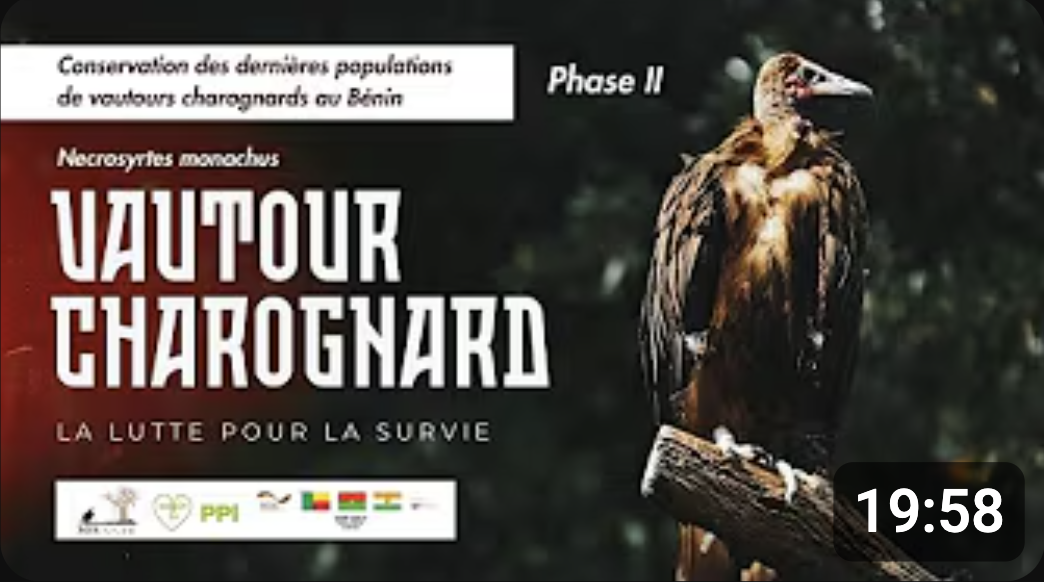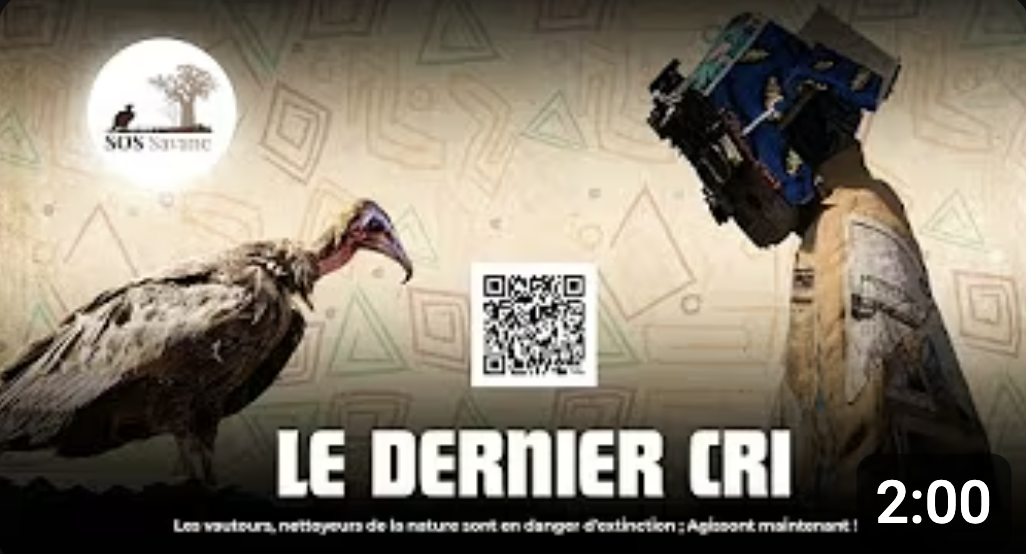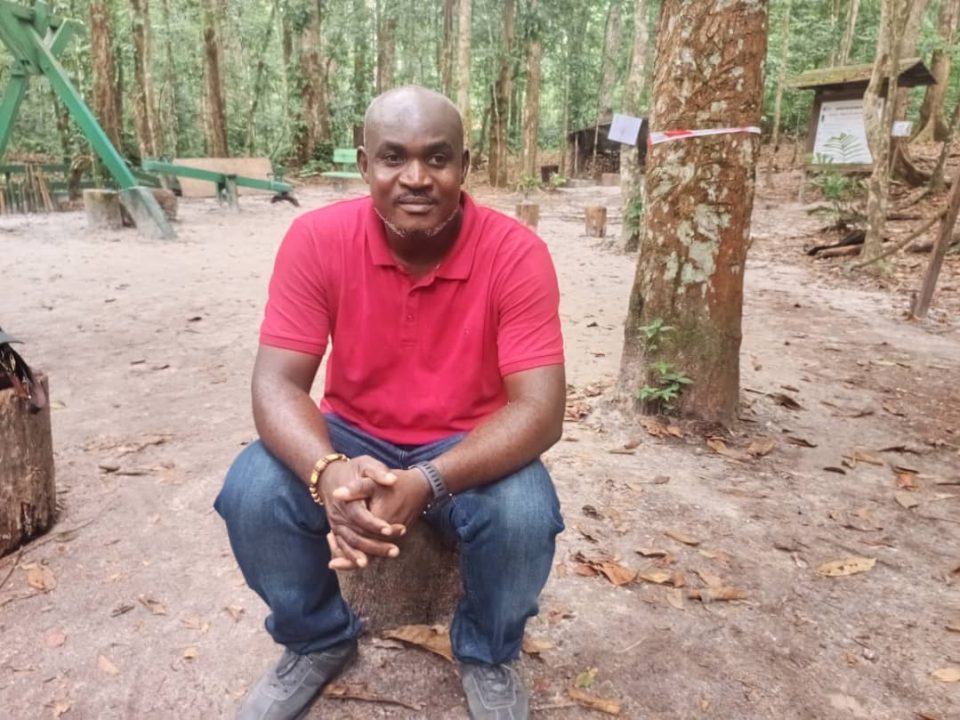On the left, two CSO members trained in beekeeping. On the right, bees entering the hive. Ghana, 2023. Credit: Marie Furtado.

PPI 6 final report, part 2: at the heart of the lands
Published on 26 September 2025From the tropical forests of Gabon to the savannas of Benin, through the remote villages of Burundi and the wetlands of Ghana, civil society organizations (CSOs) have transformed the way nature is protected on the continent. Over the past four years, PPI 6 has supported CSO projects by providing funding and organizational development assistance to strengthen their structures. Thanks to this support, local associations have restored threatened habitats, safeguarded rare species, and implemented solutions that improve both biodiversity and community livelihoods. These initiatives demonstrate that by placing people at the heart of decision-making, it is possible to reconcile the preservation of terrestrial ecosystems with sustainable development.
1 – Iconic Species at the Heart of Communities
Primates – Reconnected forests, engaged communities
Whether in Burundi with chimpanzees (EN), Ghana with small monkeys, or Gabon with gorillas (CR), PPI projects show that primate conservation depends as much on habitat restoration as on local governance.
In Burundi, the 3C association restored 659 hectares of forest corridor between two protected areas, with 30,000 trees planted, an 8 km firebreak, and the involvement of 14 eco-guards trained in SMART monitoring — a national first. A multi-stakeholder committee now oversees the actions, and the method is spreading to other parks.
In Ghana, WAPCA works in the Cape Three Points forest to protect critically endangered species such as the Roloway monkey. Through an integrated approach, more than 60,000 seedlings for reforestation have been produced, 4,800 patrols carried out, and 12,000 people reached through schools, radio programs, and events.
Finally, in Gabon, the CSO PROGRAM conducted a primate survey over 176 days, covering 118 km of transects across 30 km². The teams combined direct observations, interviews, camera traps, and signs (nests, droppings, fruit remains). The camera traps documented the presence of 295 gorillas and 43 chimpanzees. Five gorilla groups were identified: three large ones (18–26 individuals) and two smaller ones (9–18). Chimpanzees, on the other hand, appeared more dispersed, with only two groups recorded. Based on these observations, a forest non-exploitation agreement was signed, and sustainable ecotourism is now being developed.
Three contexts, three strategies, but the same conviction: local communities are the primates’ greatest allies.
🎤 Leonidas Nzigiyimpa – 3C, Burundi : “It’s a unique experience. PPI is not just a donor: it’s a partner that supports you every day, from drafting the project to seeking new funding. Thanks to them, 3C is now far more credible.”
→ vidéo Corentin (à venir)
Amphibiens – Saving a Giant Frog, Restoring an Entire Forest
In the Sui Forest of southwestern Ghana, the association Save Ghana Frogs is fighting for the survival of a species as rare as it is little known: the Krokosua giant frog (Arthroleptis krokosua, CR). Threatened by deforestation, intensive agriculture, invasive species, and poaching, this species has become the flagship of an ambitious restoration project carried out in close collaboration with local communities.
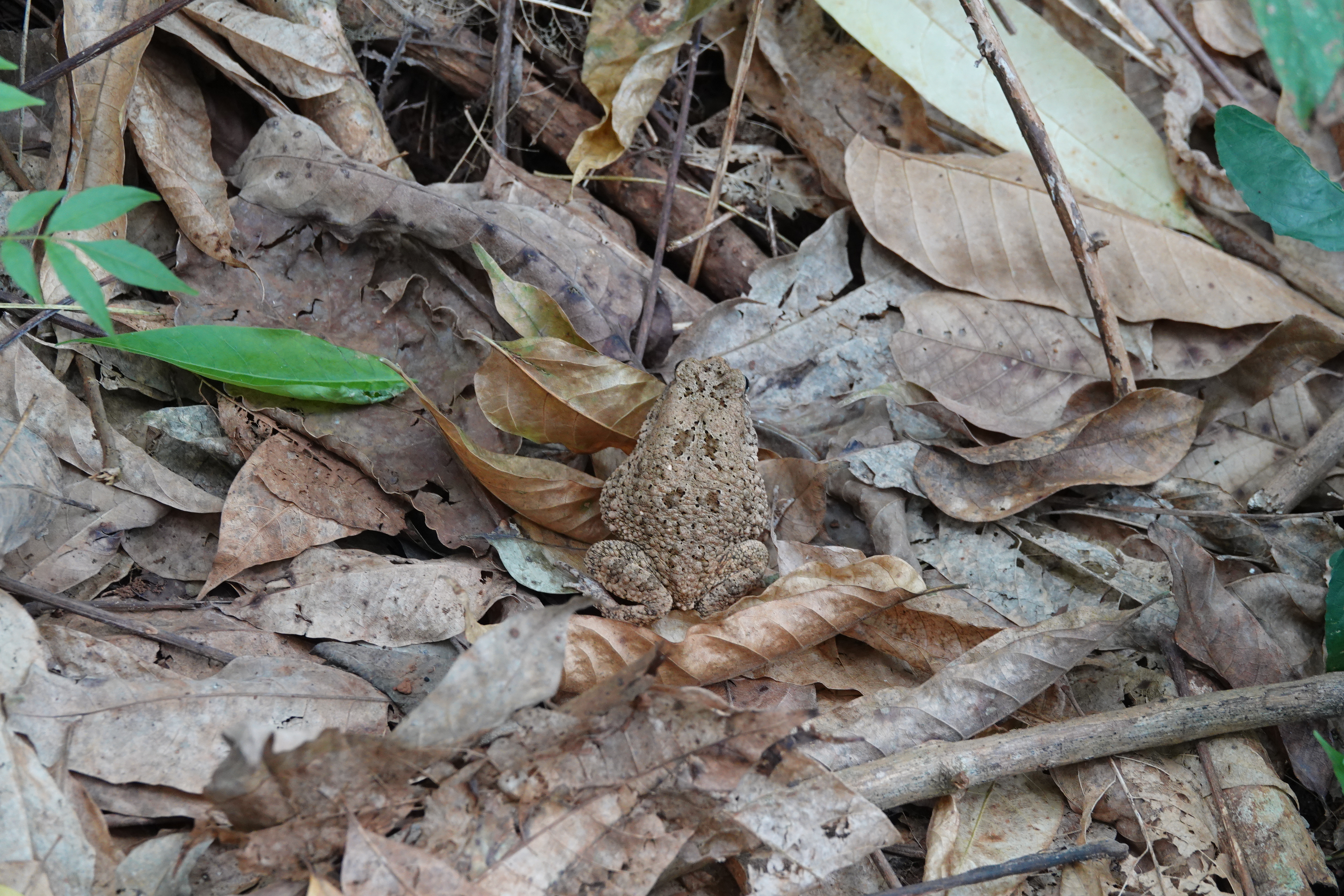
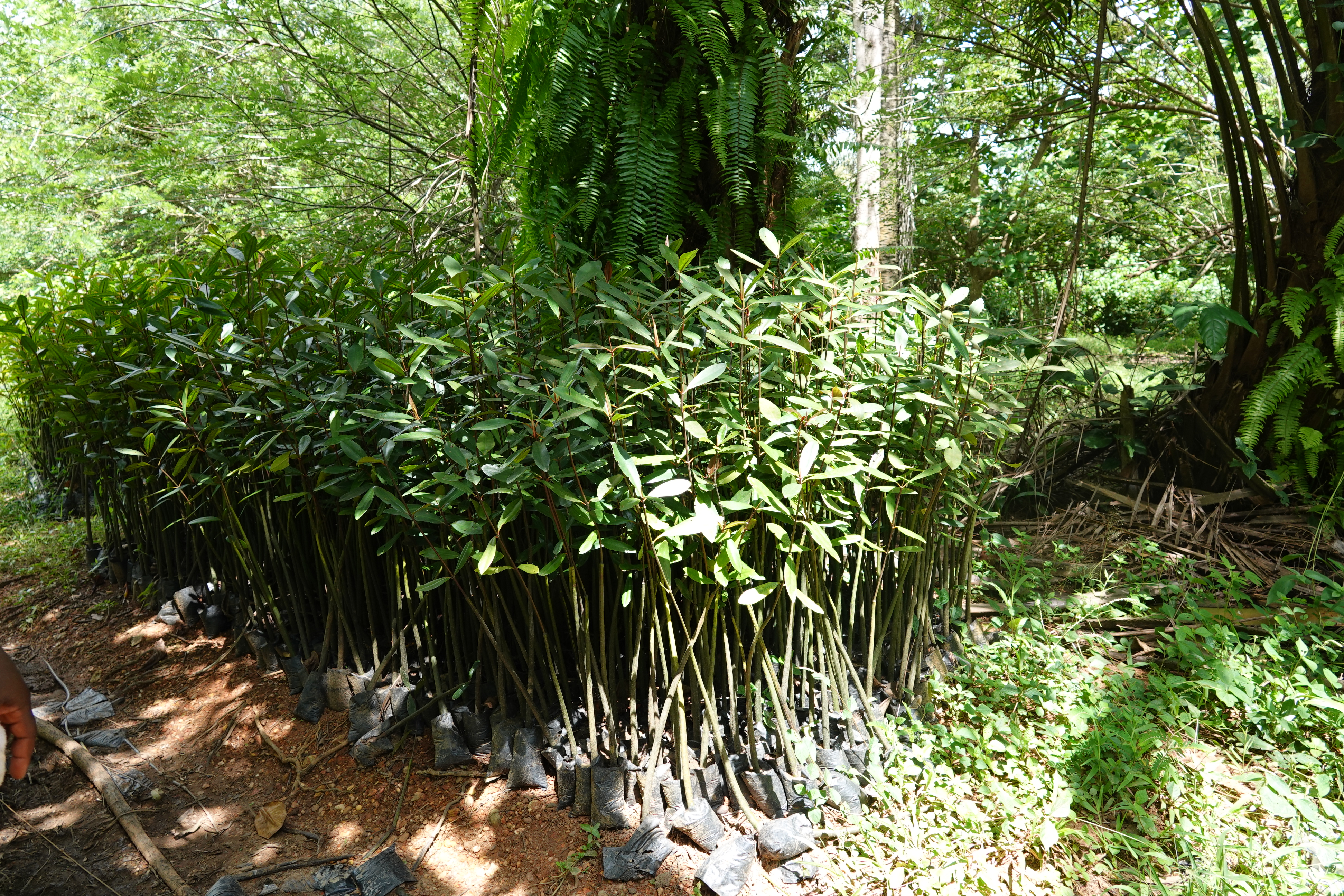
Ghana, 2023. Credit : Marie Furtado.
In just two years, 34 hectares have been restored through the production of 28,000 tree seedlings from four community nurseries and targeted weeding against the invasive species Chromolaena odorata. The ecological impact is already measurable: 13 of the 26 amphibian species recorded in the forest have reappeared in the restored areas, and 126 individuals of the giant frog have been observed, compared to only 4 in degraded zones.
But the project goes beyond the forest: it also reaches the villages. One hundred people have been trained in mushroom cultivation and 150 in beekeeping, with 95% of hives colonized and 100 liters of honey produced — the beginning of a sustainable local value chain to reduce pressure on the ecosystem. At the same time, the creation of four CREMAs is underway, and more than 8,000 people (including 3,000 children) have been sensitized through schools, local radio, and educational materials developed in local languages.


Oiseaux – Birds – Restoring the Image of the Hooded Vulture and Its Habitats
Often wrongly stigmatized, the hooded vulture (CR) is in fact a valuable ally for ecosystems and public health. In the rural areas of northern Benin, the CSO SOS Savane has made its conservation a priority, tackling cultural prejudices, deforestation of nesting sites, and the decline in food sources.
Click to watch SOS Savane’s videos!
Thanks to unprecedented community mobilization, 100% of the 165 targeted healers and hunters gave up all use of vulture body parts after being made aware of the legal framework and the species’ ecological importance. More than 2,400 residents were sensitized, and 11 local monitoring committees were created and remain active in the field.
On the ecological side, 148 individuals were recorded over 14 months of monitoring, including adults, subadults, and juveniles. Two feeding areas were secured around four slaughterhouses, allowing vultures to feed safely. In breeding areas, 12.5 hectares were restored, and 1,920 hectares of agroforestry systems were regenerated through Assisted Natural Regeneration (ANR). ANR is a technique that protects and maintains existing natural regeneration (young shoots, root suckers, natural seedlings) rather than replanting. This approach achieved a seedling survival rate of 72.5%!
Beyond conservation, the project also strengthened community resilience: 226 households received support to develop home gardens, generating income during lean seasons, and 25 hectares of fuelwood plantations were established to reduce pressure on natural forests.
In parallel, SOS Savane is testing new monitoring methods: camera traps, drones, and the development of a capture-recapture strategy — a strong signal of conservation in constant progress, driven by and for local communities.
These results for wildlife and habitats would not have been possible without another essential dimension: improving community living conditions.
In areas where pressure on resources is often high, PPI-supported projects have proven that it is possible to live better from nature while protecting it.
2 – Produce, Protect, Prosper: A Virtuous Circle
Living with Nature, Producing Better to Protect It
In rural areas, pressure on resources is often seen as incompatible with conservation. Yet PPI-supported projects show that living better from nature can also help preserve it.
In Côte d’Ivoire, YVEO works around Taï National Park, where elephants regularly destroy crops. To ease tensions, the association has raised awareness among more than 2,000 residents, trained 36 farmers in beekeeping, and mapped the areas most exposed to conflict. The first honey harvests have already generated income while discouraging African forest elephants (CR) from approaching crops.
🎤 Kouame Khassy Georges – YVEO, Côte d’Ivoire : “We were already active, but PPI taught us how to structure our vision, our strategy, and our communication. Today, other partners are reaching out to us. It’s a real springboard.”
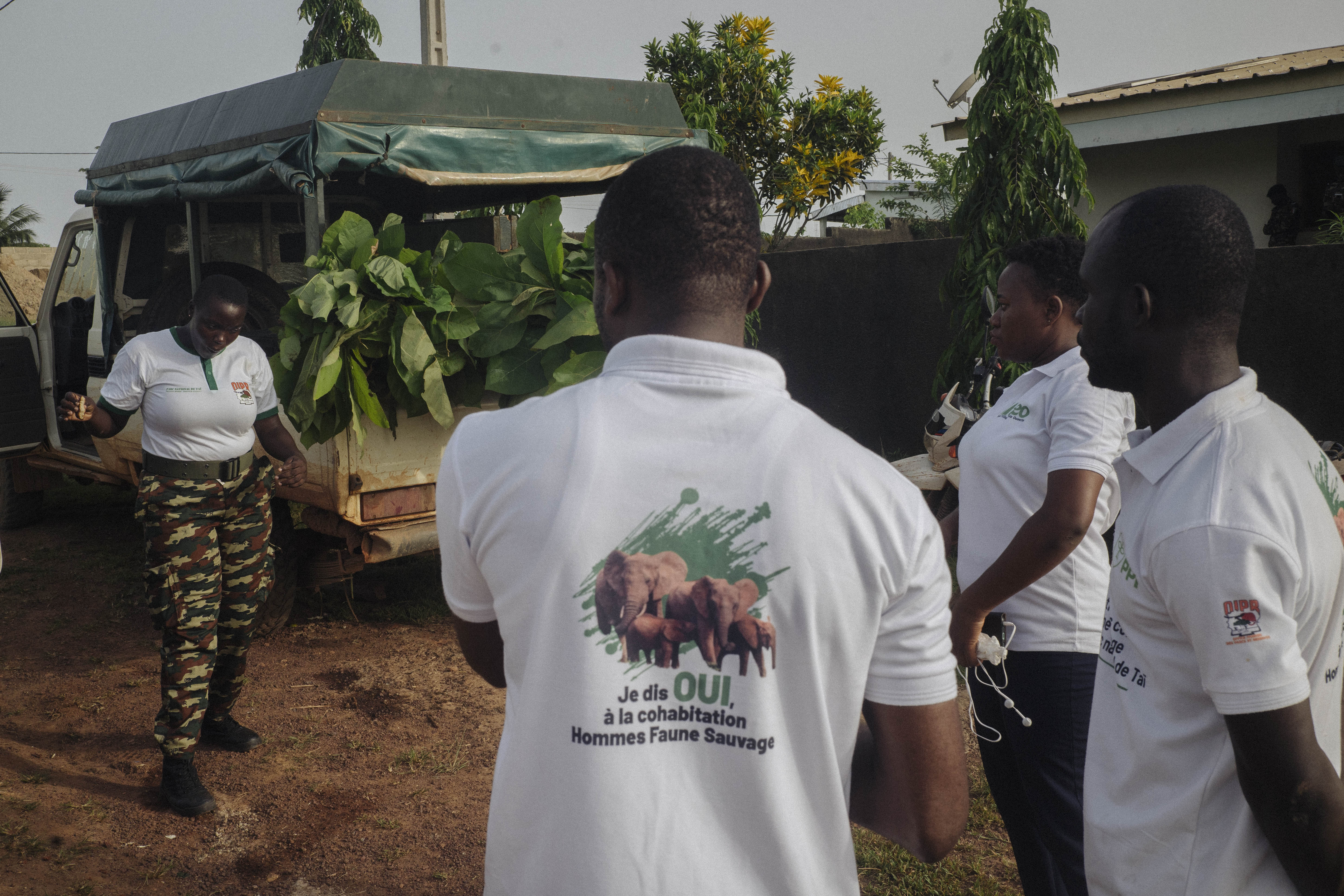
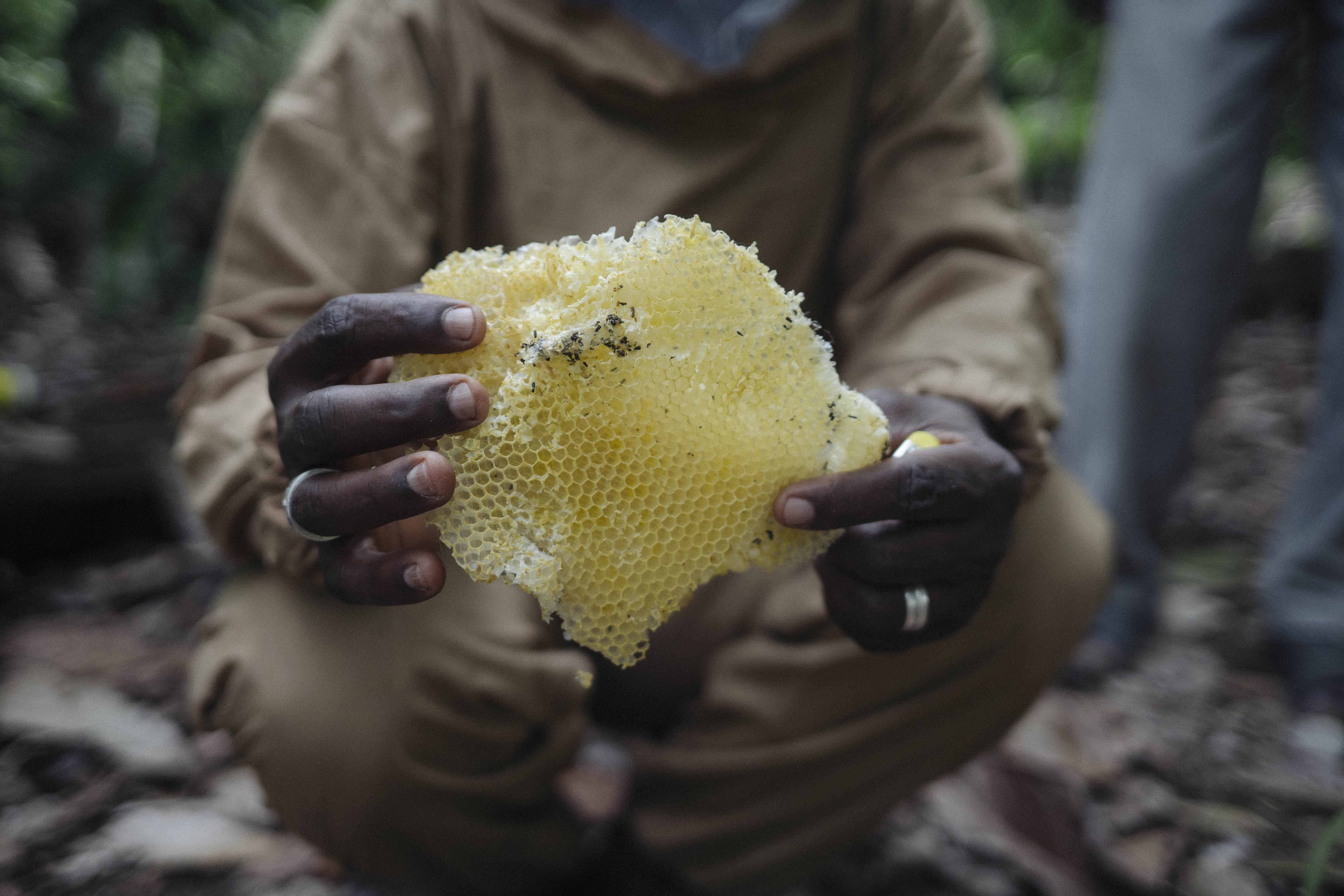
On the left, the NGO YVEO preparing for an awareness campaign. On the right, honeycomb cells without honey in a hive. Côte d’Ivoire, May 2025. Credit : Paul Lemaire.
In Cameroon, TF-RD focuses on cocoa certified “zero deforestation” and ECOCERT, along with non-timber forest products. More than 300 people have been trained, 1,000 kg of organic cocoa have been sold collectively, and a partnership between communities and a forestry company, running until 2027, guarantees access to resources while protecting the Dja Faunal Reserve, a UNESCO World Heritage Site.
Back in Côte d’Ivoire, the CSO NOFNA set up community-based monitoring in the Cavally Forest. This surveillance helps combat cocoa trafficking and poaching, and legal actions have led to six convictions for environmental offenses, contributing to the reclassification of the forest as a reserve. In parallel, NOFNA launched reforestation activities led by women: they grow seedlings in nurseries, and sales have enabled the reforestation of 30 hectares of forest.
In addition to this new source of income, the CSO also introduced improved poultry farming: “instead of going elsewhere to buy meat, we can get it right here in the village,” says Mr. Kouakou, the owner’s cousin.
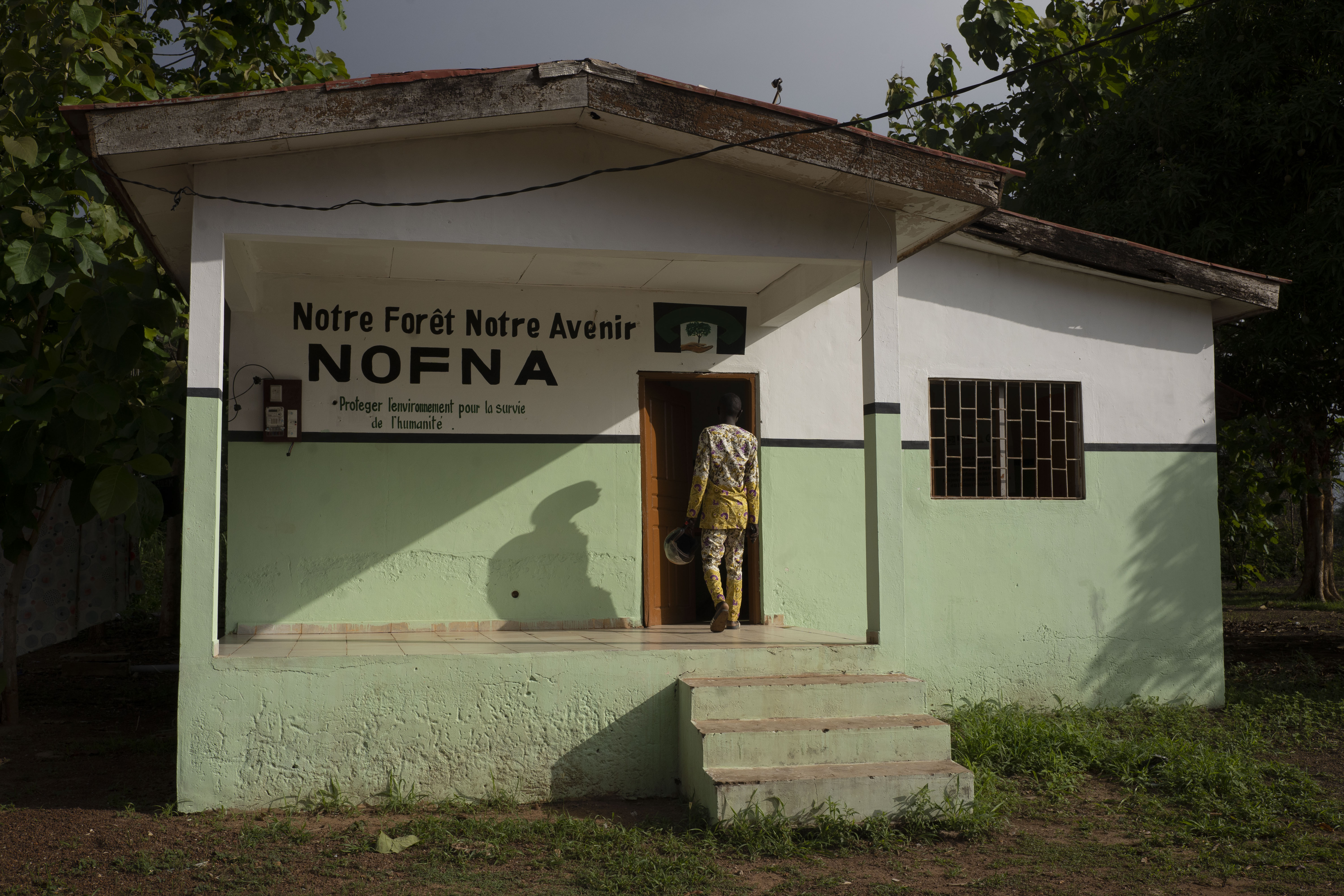
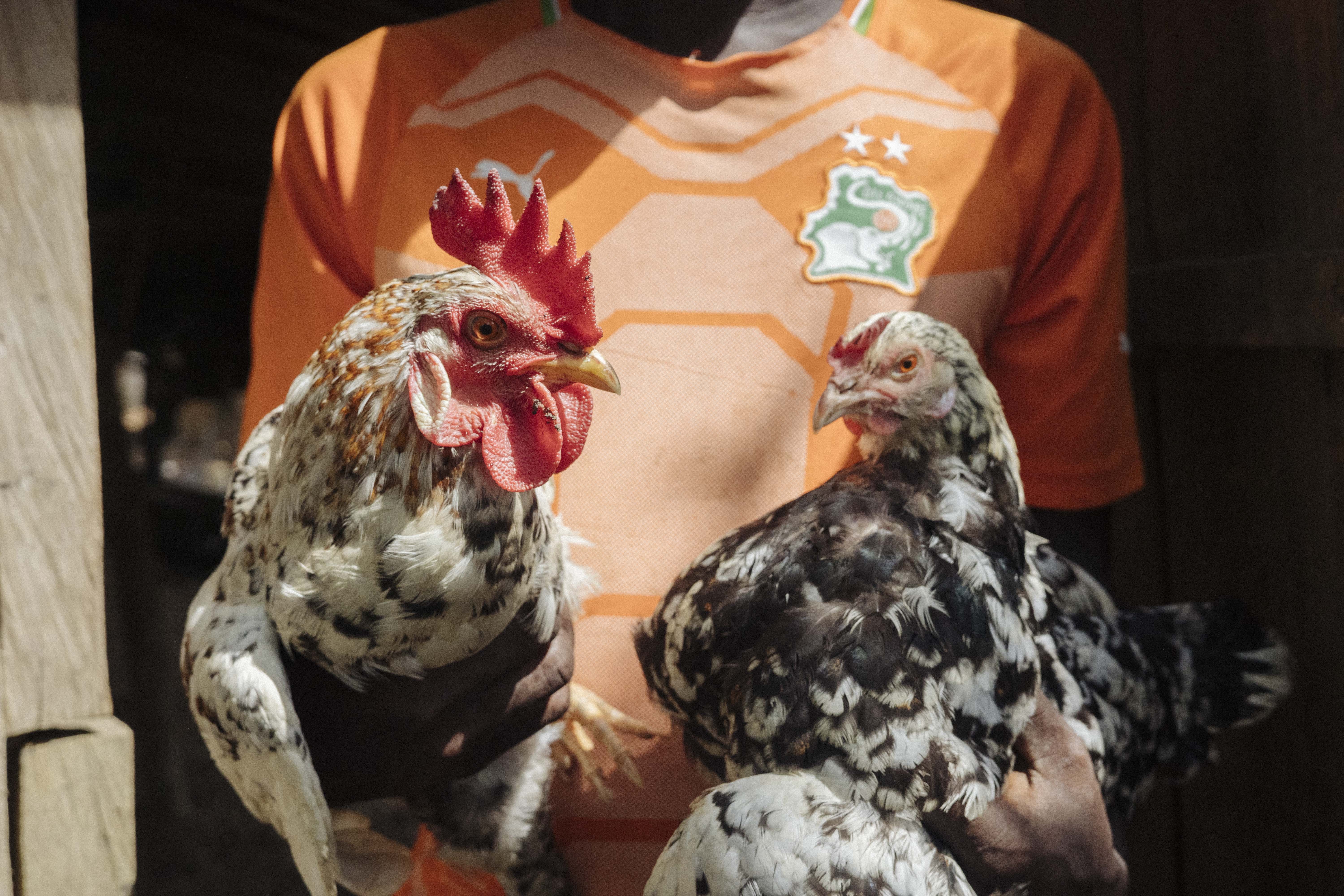
On the left, the NOFNA office in Zagné. On the right, two improved-breed chickens from the village poultry farm in Cocody. April 16, 2025. credit : Paul Lemaire.
When nature becomes the solution
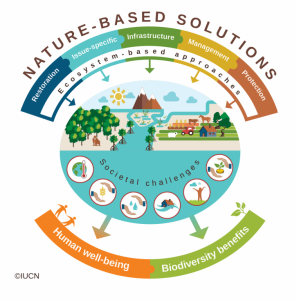
Nature-based Solutions (NbS) are actions that rely on ecosystems to address societal challenges such as climate change, food security, or human health — while also benefiting biodiversity. They aim to reconcile development with the preservation of life.
In Abomey-Calavi, Benin’s second-largest city, the CSO ACED has turned this idea into reality. Faced with rapid urbanization and very limited access to green spaces (only 0.06 m² per inhabitant), it supported the municipality in creating agroecological gardens and reforested green areas within neighborhoods.
The results: 1.5 hectares of productive gardens made available, 500 trees planted, 33 local species restored, and 10 species of pollinators attracted thanks to gentle practices. All of this was integrated into a municipal tree-planting plan (the “canopy plan”), co-designed with local authorities, scientists, and citizens.
This initiative shows that NbS are not just a concept: they can reshape cities to be more livable, more resilient, and more fertile.

But protecting biodiversity and improving livelihoods is not enough if local governance is not strengthened. To ensure long-term impact, associations have worked to give communities a central role in managing and protecting their territories, drawing on their knowledge and their ancestral bond with the land.
3 – Communities in charge of conservation
Preserving biodiversity is not limited to protecting species or restoring habitats. For results to be sustainable, it is also essential to ensure that local communities can decide, manage, and defend their territories.
During PPI 6, several associations established or strengthened governance models based on the active participation of residents: community protected areas, innovative legal frameworks such as CREMAs in Ghana (Community Management Ressources Areas), and Indigenous and Community Conserved Areas (ICCAs) in Gabon.
These initiatives place culture, local knowledge, and dialogue at the heart of conservation, building solutions rooted in the realities of the field.
Community Protected Areas
Click to watch the video (in French)!
An example from Ghana: CREMAs (Community Management Ressources Areas)
CREMAs (Community Resource Management Areas) are a tool that gives local communities a central role in managing their environment. In practice, the State transfers management powers to them over a clearly defined territory. Residents then organize collectively to set rules and make decisions that fit their needs. This organization allows them not only to protect biodiversity, but also to derive sustainable value from natural resources (fishing, farming, forests, etc.). By placing communities at the heart of governance, CREMAs promote both nature conservation and local development.
In Ghana, a CREMA supported the NGO WAPCA illustrates this approach well: local communities are restoring the forest through tree nurseries, patrolling to protect endangered primates, and developing sustainable activities such as beekeeping and ecotourism. By bringing their territory back to life, they combine biodiversity conservation with improved livelihoods.
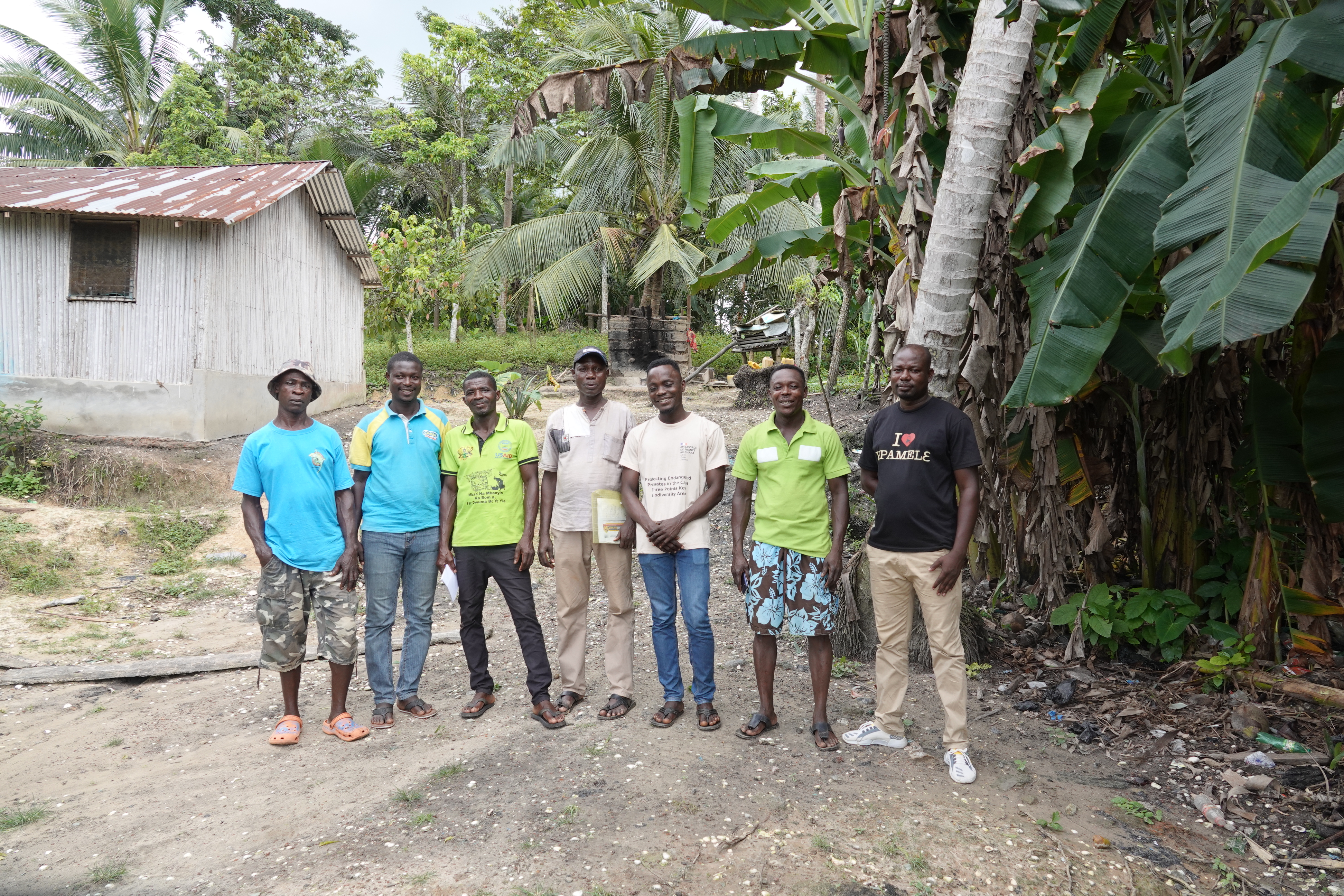
Members of the NGO WAPCA, Ghana 2013. Credit: Marie Furtado.
Indigenous and Community Conserved Areas (ICCAs): culture at the heart conservation
🎤 Savana Nnang Obiang – NADA, Gabon : “PPI didn’t just provide funding: it supported us in structuring, visibility, and even in securing new funding. Without them, we would never have reached this level.”
In the Ivindo department of northeastern Gabon, the CSO NADA works with village communities to develop a form of conservation still little known in the region: ICCAs — Indigenous and Community Conserved Areas, also called “territories of life.”
This approach places residents at the center of decisions related to ecosystem preservation, drawing on their knowledge, stories, and ancestral connection to the land. In a forest area rich in emblematic species — gorillas, forest elephants, leopards — but also under heavy pressure (hunting, gold panning, illegal logging), NADA has carried out significant fieldwork: 18 ICCAs have been identified and mapped, and 180 people from 13 villages trained in the principles of this alternative governance.


On the left, a map of sacred sites created by NADA. On the right, villagers from Mékouma. Gabon, 2025. Credit : Marie Furtado.
The communities carried out a “health check” of their territories, defined concrete action plans, and began implementing local measures for conservation and development. Thanks to the participatory mapping methodology developed by NADA, residents were able to identify sacred sites and forests within their territory, as well as natural areas of interest (watercourses, gold panning sites, hunting and fishing zones). To enhance their protection, local communities maintain these areas and have, for example, installed signs to mark the boundaries of their territories.
In parallel, a departmental ICCA network was created to share experiences, and a workshop bringing together local officials, authorities, and communities was described by the prefect himself as a “learning workshop.”
Despite logistical challenges and the lack of legal recognition of these areas in the forest code, the project generated real enthusiasm. Non-targeted villages spontaneously requested NADA’s involvement, and several cultural stories related to the territories were collected, showing that local culture is a powerful lever for rethinking conservation in a new way.
Click to listen to the podcast (in French)!
From primate monitoring to forest restoration, from vulture protection to the creation of community areas, the four years of PPI 6 have shown that local solutions, when supported and shared, can sustainably transform territories.
These initiatives have strengthened community resilience, improved scientific knowledge, and proven that ecology and development can advance together.
As the next phase of PPI takes shape, these experiences provide a solid foundation to go further, inspire other actors, and continue building a future where preserving life benefits everyone.
